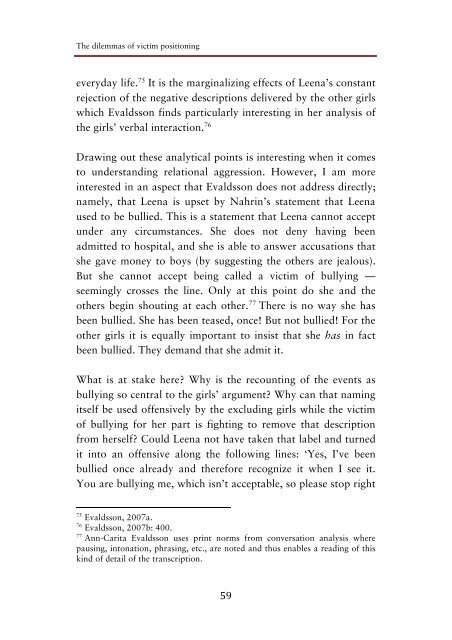Create successful ePaper yourself
Turn your PDF publications into a flip-book with our unique Google optimized e-Paper software.
The dilemmas of victim positioning<br />
everyday life. 75 It is the marginalizing effects of Leena’s constant<br />
rejection of the negative descriptions delivered by the other girls<br />
which Evaldsson finds particularly <strong>inte</strong>resting in her analysis of<br />
the girls’ verbal <strong>inte</strong>raction. 76 <br />
Drawing out these analytical points is <strong>inte</strong>resting when it comes<br />
to understanding relational aggression. However, I am more<br />
<strong>inte</strong>rested in an aspect that Evaldsson does not address directly;<br />
namely, that Leena is upset by Nahrin’s statement that Leena<br />
used to be bullied. This is a statement that Leena cannot accept<br />
under any circumstances. She does not deny having been<br />
admitted to hospital, and she is able to answer accusations that<br />
she gave money to boys (by suggesting the others are jealous).<br />
But she cannot accept being called a victim of bullying —<br />
seemingly crosses the line. Only at this point do she and the<br />
others begin shouting at each other. 77 There is no way she has<br />
been bullied. She has been teased, once! But not bullied! For the<br />
other girls it is equally important to insist that she has in fact<br />
been bullied. They demand that she admit it.<br />
What is at stake here? Why is the recounting of the events as<br />
bullying so central to the girls’ argument? Why can that naming<br />
itself be used offensively by the excluding girls while the victim<br />
of bullying for her part is fighting to remove that description<br />
from herself? Could Leena not have taken that label and turned<br />
it into an offensive along the following lines: ‘Yes, I’ve been<br />
bullied once already and therefore recognize it when I see it.<br />
You are bullying me, which isn’t acceptable, so please stop right<br />
75<br />
Evaldsson, 2007a.<br />
76<br />
Evaldsson, 2007b: 400.<br />
77<br />
Ann-Carita Evaldsson uses print norms from conversation analysis where<br />
pausing, intonation, phrasing, etc., are noted and thus enables a reading of this<br />
kind of detail of the transcription. <br />
59


